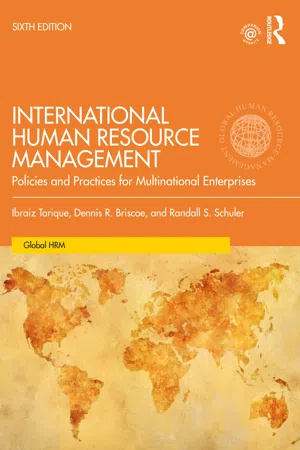
International Human Resource Management
Policies and Practices for Multinational Enterprises
- 502 pages
- English
- ePUB (mobile friendly)
- Available on iOS & Android
International Human Resource Management
Policies and Practices for Multinational Enterprises
About this book
The updated sixth edition of International Human Resource Management is an authoritative resource that focuses on international human resource management (IHRM) within multinational enterprises (MNEs). The book includes fifteen chapters with rich pedagogy students have come to expect and is organized into four sections:
- Strategic Context
- National and Cultural Context
- Global Talent Management
- Role and the Future of IHRM
Each chapter has been designed to lead readers through key topics in a highly engaging and approachable way with learning goals, relevant data, exhibits, figures, vignettes, end-of-chapter case studies, discussion questions, up-to-date content, and numerous references. The sixth edition includes discussions on evolving IHRM topics such as international experiences and adult third culture kids, expanded analyses on health and safety statistics and global workforce analytics, as well as updated and revised illustrations, cases, references, and instructor resources.
Uncovering precisely why IHRM is essential for success in international business and how IHRM policies and practices function within the multinational enterprise, this comprehensive textbook provides an excellent foundation for understanding the theory and practice of IHRM. It is essential reading for all students, instructors, and IHRM professionals.
Frequently asked questions
- Essential is ideal for learners and professionals who enjoy exploring a wide range of subjects. Access the Essential Library with 800,000+ trusted titles and best-sellers across business, personal growth, and the humanities. Includes unlimited reading time and Standard Read Aloud voice.
- Complete: Perfect for advanced learners and researchers needing full, unrestricted access. Unlock 1.4M+ books across hundreds of subjects, including academic and specialized titles. The Complete Plan also includes advanced features like Premium Read Aloud and Research Assistant.
Please note we cannot support devices running on iOS 13 and Android 7 or earlier. Learn more about using the app.
Information
Section 1 Overview Strategic context
- Chapter 1: The internationalization of human resource management
- Chapter 2: Strategic human resource management
- Chapter 3: Design and structure of the multinational enterprise
- Chapter 4: International mergers and acquisitions, joint ventures, and alliances
1 The internationalization of human resource management
“Globalization is the most progressive force in the history of human-kind. It has heralded more rapid improvements to more people than any other human intervention.”1Ian Goldin and Robert Muggah (World Economic Forum Website, 2020)
“For the past 30–50 years, the world has been undergoing a vast process of globalization, a term that describes a state of heightened interconnectivity between nations, regions, peoples, and cultures, and each acting with far greater interdependence. The results of this heightened interdependence due to globalization are evidenced in the economic, political, and social actions and policies of nations, including how we trade, live, and work with one another across borders.”2Dean Foster (Dean-Foster Website, 2020)

- Describe the many drivers of the internationalization of business.
- Describe the growth and spread of internationalization.
- Describe the different settings of international human resource management.
- Explain the development of international human resource management.
- Recruiting and selecting;
- Training and development;
- Compensation;
- Benefits;
- Income taxes and social taxes;
- Applying and ensuring compliance with federal and state laws that impact management of employees;
- Health and safety of employees; and
- Management of technology that impacts employees and employment.
Table of contents
- Cover
- Endorsements
- Half Title
- Series
- Title
- Copyright
- Contents
- List of figures
- List of exhibits
- List of case studies
- List of IHRM in action
- List of end-of-book integrative cases
- List of acronyms
- Acknowledgments
- Foreword
- Introduction
- Section 1 Overview: strategic context
- Section 2 Overview: national and cultural context
- Section 3 Overview: global talent management
- Section 4 Overview: role and future of IHRM
- Integrative cases
- Index